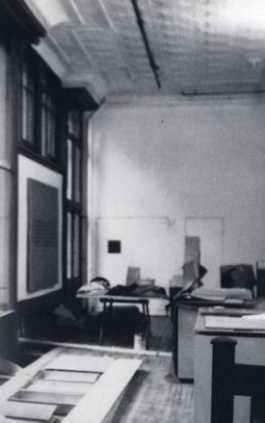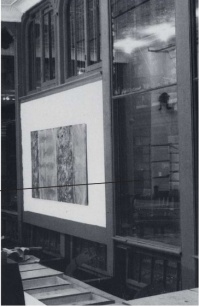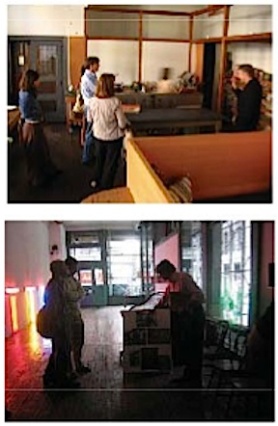by Kristina Nugent
The building located on 101 Spring Street in New York was inhabited but moreover, subtly transformed by the creative, minimalist philosophy of Donald Judd. Each of Judd’s own interventions in the building were deliberate acts. He approached the building and his inhabitation of it in much the same manner as he approached the design of his artwork. At one point Judd declared:
It isn’t necessary for a work to have a lot of things to look at, to compare, to analyze one by one, to contemplate. The thing as a whole, its quality as a whole, is what is interesting. The main things are alone and are more intense, clear, and powerful. They are not diluted by an inherited format, variations of a form, mild contrasts, and connecting parts and areas… (1)
My interpretation of the space, based on a series of visits, discussions with the Judd Foundation, and archival research focused on the autonomy yet relativity of the objects that reside there. The individual objects – and the building as the largest such object – stand as testament to an exciting art and social epoch in SoHo that occurred between the years 1968 to 1972, when Judd and his family occupied the building which functioned as both their home, and his primary studio.
The first grounding condition for my project was a desire to examine the collection of art and everyday objects, as well as the theories and aspirations that accompanied them, which came to be “permanently installed” in 101 Spring Street by the artist himself. Existing interpretations of 101 Spring Street have tended to emphasize the differences; the building as a home versus its use as a de facto gallery space for permanently installed works of art.
My interpretation aimed to show that drawing comparisons between the everyday domestic items and art objects would not limit, but rather expand the significance of the collection. This allow us to think more broadly about what Judd was trying to achieve both formally and conceptually, and why these aims are so compelling when interpreted within the particular historical context of 101 Spring Street.
An emphasis that ran throughout my interpretive experiment was to understand what the artist intended and how the works were seen or meant to be seen in the lifetime in which they were made. Of course I did not intend for this history to pretend to forget the experience of the work in the present. But I found myself wanting to have that experience in the present be as much informed as possible by what we know of the original context. This is in part because I found that many aspects of that original context carried over into the present. Many of the questions that were being asked continue to be asked. Beyond my hope for how a more objects-based interpretation might have contributed to our formal under- standing of Judd’s work and life, there was also the fact that Judd was not working in isolation and the visitor experience of 101 Spring Street needed to draw the visitor’s attention to those interactions. The experience needed to allow the viewer to become self-reflexive.
In order for the visitor to better relate to the inanimate objects and understand the non-physical and historical dimension of the collection and greater building, a historically-based interrogation of the objects seemed paramount. The irony of Judd’s work and life, and the interpretation of its Minimalist, or Reductionist principles is the sheer complexity of this task. As Hal Foster observed in The Return of the Real:
On first glance it all looks so simple, yet in each body of work a perceptual ambiguity complicates things. At odds with the specific objects of Judd is his nonspecific composition (‘one thing after another’) … So what you see is what you see, as Frank Stella famously said, but things are never as simple as they seem … perception is made reflexive in these works and so rendered complex… Minimalist sculpture no longer stands apart on a pedestal or as pure art but is repositioned among objects and redefined in terms of place. (2)
The material records found in 101 Spring varied from Judd’s industrially fabricated cubes, to works of art from his peers and mentors, common kitchen utensils, as well as tribal artwork of Judd’s personal collection. My first impulse was to approach each object and ask how and why these objects are situated in a particular place and in relation to other physicalities and psyches that occupy the space. My proposal was to address each object, individually but relativistically through the means of an interdisciplinary discourse investigating what those circumstances (both historical and present) might mean, and how they might change as the building is restored or through the passage of time.
After inventorying all of the objects in the home and studio space that ranged from banal house- hold items to contemporary artistic masterpieces, there were hundreds of items; far too many to explore all at once. So I began to devise a strategy for interpreting the greater collection. I elected to begin with the “permanent installation,” of works of art, not by Judd, but by his contemporaries. These artworks were either gifts to Judd or purchased by Judd, and he installed them in 101 Spring Street in a manner consistent with his artistic philosophy. Many of Judd’s own formative concepts grew out of a critical understanding of the work of other New York artists during his time. Frank Stella and Claes Oldenburg were specifically referenced in Judd’s treatise on ‘Specific Objects’ in 1965. Since these works were so crucial to the personal history and development of Judd as an artist, they seemed to be a logical starting point for my interpretive concept:
The Conservation of the Novros Fresco
Now that the topic was narrowed down to a few dozen objects, I came upon a piece of artwork commissioned by Donald Judd in 1969 that seemed to encapsulate both his idea of “permanent installation,” of Minimalism, and had been unavoidably damaged with oil stains that were slowly seeping through the floor joists of the building from the ceiling above and required continual intervention by both the artist, and involvement by Judd himself. The artist of the piece, David Novros began the execution of a traditional fresco in the minimalist aesthetic in 1970 on the second floor kitchen space of the home and studio of Donald Judd. According to the artist, this was the first buon fresco he attempted:
When it was done, took into consideration every possible contingency about damage. [Judd and Novros, together] took the wall down to the brick, we scrubbed the brick with acid, we did everything we could, and really approached it from absolute by-the-book form. When it was finished it was perfect; essentially, technically, and it stayed that way for a couple of years.”
Yet, the inherent conditions of 101 Spring Street, a former garment factory, created unforeseen complications in retaining the original intention of the artist and his patron:
After three years, a stain began to appear in the center in the white area, coming from the ceiling. After awhile the stain spread. It also spread on the floor above and started to brown the plaster walls. The stain, I think, and so did most of the people who were there and so did Don at the time, was coming from oil on the jousts of the floors when this place housed machinery. And this oil was migrating ‘willy nilly’ down the walls and was staining the painting. I attempted to restore it. I tried to seal it off and touch-in the affected areas. At that time, there was not too much damage. But the stain re-appeared and it kept reappearing and I kept trying to restore it and this went on for a number of years. (3)
At what point should the artist have discontinued his intervention? Was the rationale be- hind these successive efforts flawed to begin with? To what extent is this activity permissible? According to what standards of care? For most practitioners in architectural and fine arts conservation, retaining authenticity meant leaving the historic objects alone and conserving them using as much original material as possible. This accomplished, to the greatest extent possible, a visually unaltered presentation of an important remnant from the past. Yet, within the standard and most-often-referenced conservation guidelines promoted by the American Institute of Conservation, flexible standards and guidelines apply to works of art where justification for a more radical conservation approach is available.
Traditional Fresco Conservation Methods
In traditional paintings conservation there have been two camps—imitative restoration and trateggio that are most often discussed in relation to European works of art before 1900. Imitative restoration came out of the connoisseurship world and held the viewpoint that with the proper knowledge of an artist’s technique, use of ma- terials, and careful analysis, it was possible to recreate the areas of loss so that the work read as a unified whole.
To achieve this, the conservator generally applied a separating layer of varnish and then worked in custom water colors to add the missing elements, or correct the flaws, into the original image. The theory was that this intervention could all be wiped away with a damp cloth if tastes or conservation principles changed and it was useful to see the actual image with losses.
Trateggio, the other school of thought, was an Italian conservation method pioneered by the Istituto Centrale di Restau- ro (ICR) in Rome and championed by Cesare Brandi, an early and influential writer on conservation practice. Using this method, the conservator did not imitate the losses, but used sympathetic tones and tiny cross-hatches to fill the voids so that at an appropriate distance the eye “filled in” the space, but on close inspection it is clear that the losses remain.
Conservation of Contemporary Art
In recent years, works by Contemporary artists have posed new challenges for art conservators, who have in turn developed new techniques and ways of determining appropriate conservation treatments in response to these challenges. On January 24th to 26th of 2008, the Getty Conservation Institute hosted a conference to investigate, “The Object in Transition: A Cross Disciplinary Conference on the Preservation and Study of Modern and Con- temporary Art.” The conference set out to address these very challenges faced by conservators, art historians, curators, and artists regarding Modern and Contemporary artworks:
There is often no codified method for conserving such works; further, the insistent but uneven rate of deterioration present in many objects has left us with countless works of art that now diverge starkly from their original form. The practical and interpretative problems that arise in relation to durability and ephemerality in modern and contemporary art are exacerbated by an art-historical methodology that tends to privilege theoretical interpretation over concrete object study.
The descriptive knowledge that originates in object and technique-based study has increasingly left the field of art history, falling instead within the domain of art conservation… However, the challenges posed by modern materials often lead to decisions about an object’s preservation and acceptable aging that are based on more subjective inferences about the artist’s original intent—an interpretive concept that many art historians view with some skepticism.
Returning to the Novros fresco at 101 Spring Street, it poses a similar challenge as the one described above. On the one hand it was executed using traditional buon fresco techniques and could arguably be conserved according to standard fresco conservation methods, previously described, which include either imitative restoration or trateggio techniques. Yet, Novros’s fresco, which is categorized as a Minimalist piece of artwork, would then be considered neither “painting nor sculpture,” following Judd’s insistence, he articulated in “Specific Objects.” Therefore, this fresco necessitates a unique conservation solution, which is more in keeping with the challenges the Getty Conference attempted to address.
In common practice, there appears to be a disconnect between the various schools of thought regarding restoration of Contemporary artwork. Rarely are professional standards and personal opinions forced to be publicly reconciled in order to reach a more comprehensive resolution of how to best proceed with the art object in question. Philosophical underpinnings of artistic intent juxtaposing museum and standards of conservation and care must be negotiated in order to reconcile the historicity and the integrity of an object.
This interpretive exercise required me to jump ahead and make several assumptions in order to reflect on the value and utility of my proposal. The oil stains interfered with the reading of the artwork and masked the original artistic intent of Novros, and Judd who commissioned the work. I decided that the fresco required an extensive level of intervention, but grappled with how best to proceed. The American Institute for Conservation’s guidelines mentioned that, “In some cases a decision to allow deterioration to occur by avoiding certain preservation practices may be appropriate. Such decisions should be made only in collaboration with appropriate individuals connected with the cultural property.” When does an art object become historical – and how can we reconcile this notion by contrasting it with the point in which an object loses its integrity?
In this case, the living artist was consulted on the matter, and he insisted that if deterioration were allowed to occur, the entire piece would be lost since the oil seepage was gradual yet unending. Ultimately the entire fresco would read as an oil stain. Given the fresco’s importance, both to the artist and the Judd Foundation as the first permanently installed piece in 101 Spring Street, the conservation treatment would need to be somewhat radical. The artist’s suggestion of inserting a thin membrane of an impenetrable substrate over the original fresco and simply applying new plaster and pigment to this new surface was a suggestion that seemed sensible. For one thing, the original piece was protected and retained under the new layer of material and a careful replication of the work would be inserted as close to the original location as possible. How would the membrane affect the replica? The artist was not a conservation specialist, how can he possibly predict whether this is indeed the best solution. How would this treatment affect the rest of the building? Wouldn’t a restoration architecture firm need to be consulted. What is the cost associated with this intervention?
How has the Judd Foundation prioritized this conservation project over other projects scheduled for 101 Spring Street? What were the associated costs? The point is that these decisions are not simple and can not be entrusted to one contractor, or resolved by hearing one opinion. We shall soon see as Judd’s Home and Studio is set to open in June 2013!
It will be exciting to see what programs will be announced shortly. I am hopeful that aside from viewing art, another goal of the Foundation will be to open up these dialogues, and to re-visit the objects of 101 Spring Street, understand their individual and collective meaning, and enliven the context for the interpretation and conservation of 101 Spring Street. I look forward to once-again returning to 101 Spring Street to re-visit the extraordinary life and work of Donald Judd.
Please visit the Donald Judd Foundation for more information about Judd’s Home and Studio and the completion of the restoration and re-opening to the public in June 2013.
1. Donald Judd, 1965 in Twentieth Century Artists on Art. (New York: Pantheon Books, 1985), 220-221.
2. Foster, Hal. The Return of the Real: The Avant-Garde at the end of the Century. (Cambridge: MIT Press, 2002), 37-38.
3. (These statements were transcribed from the conference held at the Getty Institute in Santa Monica held on Saturday 26, 2008 on the topic: ‘The Object in transition: A Cross-Disciplinary Conference on the Preservation and Study of Modern and Contemporary Art.’)















